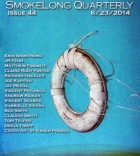Your story “Fumigation Day” is written in present tense, yet from two different actual times and geographical places. That all makes for a lovely complication of perspective. How did you arrive at this construction and that narrative strategy?
So many different times can exist in a single moment, and I think a compressed form like flash lends itself to that dense simultaneity, the layering of multiple temporalities in a brief instant, an afternoon, or a day. It’s one of my interests in the form. Bergson said that we laugh when we see something mechanical encrusted in the living—like a person slipping on a banana peel—it’s the eeriness, the oddness of what’s dead or unconscious in what’s alive that makes us laugh. This piece originated in a related but different feeling, this one about time: the sense of a vivid, loved present moment turning into just a recording, a memory, becoming ephemeral, dying to you as you experience it. This feeling involves imagining looking back at the present moment from the future while you’re in it, and missing its presentness intensely. In this story, that anchor moment is the scene where Chloe eats the blackberries—the other temporalities grew out of that.
Ken the fumigation guy is a carefully developed character who first appears through a peephole, then comes in to take the stage of the story in unnerving costume, and by the end plays the key and pivotal role. Was it difficult keeping such an unruly colorful character under control?
The distortions in perspective by which Ken appears with a fishbowl face, as a balloon-like astronaut, and then in a gesture so key to the story when his arms make a hollow for his absent daughter—all of it, to me, is filtered through the pressures of fullness and emptiness, plenitude and loss, that course through this story’s narrator. The narrator experiences her own seismic shifts of connection and alienation playing out in Ken’s changes in size, costume, weight and solidity. Ken, I think, is actually a pretty regular guy—rosy-cheeked, practical, good at his job. What he does at the end of the story is a pain in the ass for him, but a kindness to the narrator—one of those decent human being things to do. Though your question makes me wonder what he does with the object with which he’s saddled. He doesn’t use it or throw it away. I’m seeing a back corner of his storage shed and then, years later, Goodwill.
Your title works as a very strong metaphor for the story itself, which seems to be about the house of memory, our need to clean it out when it’s time to move on, but also our desire to preserve and pass on that which is most meaningful. Could you talk about that?
Getting fumigated is terrible. The second origin point for this story involved a moth infestation in my current apartment building and the need to vacate the apartment for a full day every couple of weeks to avoid being poisoned—a day my husband and I dubbed Fumigation Day. Fumigation poison makes your home into a creepy not-home, your things into lurking, troublesome ballast rather than a collection of cozy, familiar items with sentimental value. You just want to throw all of this poisoned stuff away—every cloying, contaminated bit of it. So being fumigated is also liberating, bringing up the unhomely sense of being freed of all the things you own, loosed from your habitual surrounds and memory hoards. Our collections of significant objects are minefields of the other selves we’ve been, and the very fact that we hang onto them introduces the fantasy that we might shed ourselves of all of these objects, all the other selves they evoke, along with the burden of feeling they carry.
The story is full of sentiment and sympathy, especially the throb and ache of parental love, yet it never becomes melodramatic. How did you manage to walk that fine line?
That’s good of you to say! This is a line I try to walk in my own life. Psychoanalysis helped.
Stories are always made of however many words it takes, but how did “Fumigation Day” arrive to be the size it is? Did it expand as you wrote it, or did you have to confine or curtail it? Did it require a lot of editing, many drafts? Or, as we say, did it come in a flash?
As in the title of your wonderful anthology, Sudden Fiction, it was rapid. It started as a shadowy penumbra, a hunch that lurked inside for a while and then loomed and unfolded on the page in two days, a complete draft. I didn’t know what would happen when I started it, but I knew my starting point was that cedar chest. (The third origin point for this story involved my mother’s passing on such a thing to me.) The story came as a complete package, opening up as I wrote it, a little gift. Then I revised it, tweaking words and sentences and sections, for a while. For me, a good flash is like a knock on the door—the welcome herald of a beloved guest’s arrival, the intimacy and strangeness of sharing your home, and then when your guest leaves, all of a sudden, you’re done.



 Included in the price of SmokeLong Fitness:
Included in the price of SmokeLong Fitness: